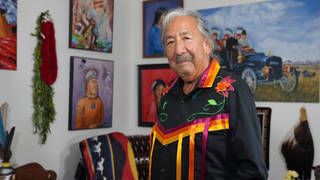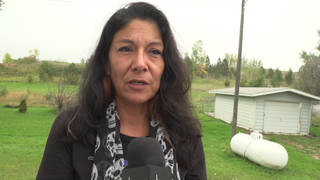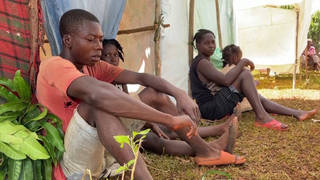
In the airport in Port-au-Prince, huge pallets of aid, including medical supplies, food and water, sit in fields around the tarmac. Amy Goodman reports on how hundreds of cases of bottled water are being delivered to the US embassy. [includes rush transcript]
Transcript
AMY GOODMAN: The figures now, Juan, are something like, well, two million people perhaps homeless, either their homes destroyed or afraid to return to their homes. The numbers of people dead, we can’t even know.
JUAN GONZALEZ: No, I don’t think it will ever be known, the exact number dead, because in a situation like this, with so many bodies being buried in mass graves and the record keeping in Haiti not, you know, at the level here as in the United States or other countries, it may be impossible to really tell the actual number of dead.
AMY GOODMAN: They’re saying they’ve actually counted so far 75,000, something like that, bodies. But they’re saying it could be 100,000, it could be 200,000.
JUAN GONZALEZ: Yes.
AMY GOODMAN: An entire country rocked by this horror. And the question is how they recover, in two ways. One is the natural catastrophe, and the other is the infrastructure of Haiti.
You know, you, yourself, experienced an earthquake.
We, when we were with Jean-Philippe Oustalet at the airport, right after we did the broadcast here, we didn’t even know the level of the — what’s called an aftershock, which is actually an earthquake, that took place earlier in the day when we were unfortunately inside a house — for a moment, it took place — as the whole place rocked. And as we ran out, people were screaming, crying, hugging each other. But he talked about that. He said that they were going out yesterday, because they didn’t know how many people had died or were trapped in the rubble from that.
JUAN GONZALEZ: Well, and not only that, but the aftershocks sometimes are even more terrifying than the original earthquake. I remember in covering the Northridge earthquake in California more than a decade ago now, and I had got there hours after the quake had occurred and was actually in my hotel room writing a story, on the tenth floor of a hotel writing a story, when all of a sudden an aftershock hit, and the entire building started swaying. And I had not experienced the original earthquake, so I was not even aware what was happening until I rushed out into the hallway and saw one of the maids in the hotel who had actually been in the first earthquake. And she was essentially totally catatonic. She was on the floor yelling and screaming, because she realized it was coming again. And that sense that the catastrophe that you’ve already been through is being visited on you again, those aftershocks can be even more psychologically terrifying than the original quake.
AMY GOODMAN: So you have, for the survivors, the fear of this happening again, and you also have the fact that so many of them have not gotten aid, have not gotten water, have not gotten food. In fact, yesterday, just before we left Haiti, we were walking around the airport, where there are huge pallets of aid, including medical supplies, food and water, sitting in the fields all over the tarmac.
AMY GOODMAN: Everywhere we have traveled, people have asked, “Where is the aid?” Well, a lot of it appears to be here, right here at the Port-au-Prince airport. People ask for water. They ask for food. And we see many, many pallets, thousands of bottles of water. We see some being loaded now onto a truck. But people are asking, “Where is it? Why isn’t it coming to us faster?” Most people haven’t gotten it at all. Let’s see where this water is going.
So, where is the water going?
HAITIAN WORKER: US embassy.
AMY GOODMAN: To the US embassy.
HAITIAN WORKER: Yes, ma’am.
AMY GOODMAN: Here in Port-au-Prince?
HAITIAN WORKER: Yes.
AMY GOODMAN: A lot of people have been asking, where is the water for the people? There are thousands and thousands of bottles.
HAITIAN WORKER: I don’t know.
AMY GOODMAN: Where do you live?
HAITIAN WORKER: Ah?
AMY GOODMAN: Where do you live?
HAITIAN WORKER: I’m living in Port-au-Prince.
AMY GOODMAN: Do you have questions like that?
HAITIAN WORKER: Ah?
AMY GOODMAN: Do you have questions like, where is the aid?
HAITIAN WORKER: No.
AMY GOODMAN: Where is the water?
HAITIAN WORKER: No.
AMY GOODMAN: Why?
HAITIAN WORKER: Because I’m working for US embassy. I’m coming to pick up the waters, to put them for — to US embassy.
AMY GOODMAN: And who gets it at the embassy?
HAITIAN WORKER: In Taba.
AMY GOODMAN: Ah, in Taba. And who gets to drink this water?
HAITIAN WORKER: I don’t know.
AMY GOODMAN: Just one scene at the airport yesterday, finally seeing some of that water being taken and being told it was going to the US embassy. We don’t know what would happen to the water there. Of course, there are large staffs that have come in from all over. But the question is, when will the Haitian people, all over, from Haiti to Léogâne to Carrefour, the epicenter — the water, the food — have access to that?
JUAN GONZALEZ: You know, Amy, and it’s amazing. One of the things I mentioned to you before you left is, I didn’t really understand why the closest land mass to Haiti other than the Dominican Republic, with which it shares an island, is Cuba, and in fact the Guantánamo Bay Naval Base is very close to Haiti. There are 9,000 US Marines there. They have their own desalinization plant, because they had conflicts with Cuba in the past over water supplies. They have huge reservoirs of water. It would have been really a quick action on the part of the United States to send a few thousand of those Marines immediately to Haiti in the first days with the water and the earth-moving equipment and all that stuff that’s right there in Guantánamo. And imagine the image of Guantánamo to the world as, instead of being a place that just tortures prisoners, that the Marines on Guantánamo had moved quickly in the first few days to assist the people in Haiti. Didn’t happen. And it took — even now, it’s about a couple of thousand of US soldiers are there, and they’re not necessarily playing the most — the best role that they can in this situation. So it just baffles me that they didn’t immediately bring the people in Guantánamo into action.
AMY GOODMAN: I mean, China sent a plane.
JUAN GONZALEZ: Yes.
AMY GOODMAN: One of the first, halfway around the world.
JUAN GONZALEZ: Yes.












Media Options